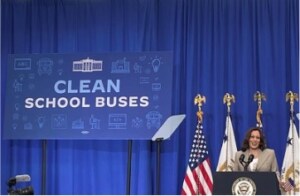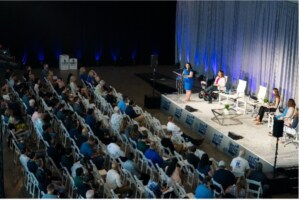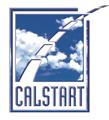Top Ten Considerations to Effectively Implement Commercial ZEV Infrastructure Improvements Under NEVI
By Alycia Gilde and Nathan Fernandez
We are at a pivotal moment in our nation’s history where smart and timely actions are required to combat the threat of climate change. Transitioning vehicles from fossil fuels to zero-emission technology is critical to mitigate the effects of the climate crisis and reduce the impact on public health, especially in communities disproportionately overburdened by transportation emissions.

Vice President Harris announcing the release of $500 million in IIJA funding for clean school buses last month. More ZEVs on the road means that states must place equal importance on charging and fueling infrastructure to support these vehicles, especially for commercial applications.
As the nation moves forward with implementation of the Bipartisan Infrastructure Law’s (IIJA’s) National Electric Vehicle Formula Program and discretionary grant program for Charging and Fueling Infrastructure, affordability and accessibility of zero-emission vehicle (ZEV) technology will increase, leading to job creation, technology adoption, and prosperous and healthy communities. While IIJA funds do not meet the full demand anticipated for a national charging network, these investments by the Biden-Harris Administration have catalyzed over $700 million in private section investments for American-made ZEV chargers, which will help build 250,000 new chargers annually and add at least 2,000 manufacturing, installation, and maintenance jobs to support U.S. infrastructure.
However, it is critical that states and manufacturers include commercial ZEV infrastructure needs into their respective programs and investment strategies. Effective infrastructure planning and implementation for commercial ZEVs must be considered a priority in line with light-duty passenger vehicles. Incentivizing the deployment of electric charging and fueling infrastructure for commercial ZEVs can help bridge infrastructure gaps, provide equitable access to resources, and create innovative public-private partnerships.
Having led alternative fuel corridor partnerships and served as ‘boots on the ground’ for numerous infrastructure deployment projects, including the $276 million Energy Infrastructure Incentives for Zero-Emission (EnergIIZE) Commercial Vehicles Project, CALSTART understands the essential elements of strategic planning, assessment and prioritization, and partnerships to meet the charging and fueling needs for commercial ZEVs. With members of the Clean Fuels and Infrastructure Policy Action Group (PAG), we have summarized the key considerations for prioritizing incentives for commercial ZEV infrastructure.
Considerations for Commercial ZEV Infrastructure
1. Stakeholder Engagement

SDG&E’s EV Fleet Day in April brought together fleet operators and managers, charging providers, fleet software companies, and vehicle manufacturers, as well as SDG&E fleet electrification staff, public agencies, grant and funding organizations, and more. Photo by SDG&E.
Conduct outreach to and engage with public and private stakeholders and community-based organizations to site and prioritize commercial ZEV infrastructure to increase adoption in disadvantaged, low-income, and rural communities. A broad coalition of viewpoints is important to gather, including commercial fleets, utilities, community-based organizations, governments, and industry partners. Consider the creation and use of an equity and engagement plan.
2. Freight Focus
Prioritize commercial ZEV charging and alternative fueling infrastructure near urban centers and freight hubs such as ports, distribution centers, warehouses, and railyards to reduce emissions impact on communities. Help stakeholders understand the key infrastructure and technology differences required for medium- and heavy-duty vehicles.
3. Convenient Fleet Access
Accommodate public commercial ZEV charging and fueling needs such as turning radius, truck parking, restrooms, and amenities for fleet operators.
4. Higher Power DC Fast Charging
Deploy electric charging stations that accommodate commercial ZEV charging needs and encourage futureproofing to enable higher power charging as technology evolves.
5. Infrastructure AND Vehicle Incentives
Roll out incentive programs for commercial electric vehicles and infrastructure in parallel to best support market development and commercial ZEV adoption needs

EnergIIZE, California’s Hybrid and Zero-Emission Truck and Bus Voucher Incentive Project (HVIP), and California’s Clean Off-Road Equipment Incentives (CORE) offer incentives for commercial electric vehicles and infrastructure. Click on each logo to learn more about these programs.
6. Flexible Fueling
Consider funding ‘behind the fence’ electric charging and alternative fueling infrastructure that provide depot-based fleets with flexibility for shared commercial fleet use.
7. Microgrid Deployment
Establish Distributed Energy Resource (DER) and DER Management System installation requirements at public and private charging locations to support local utility grid resiliency and reliability.
8. Utility Electric Vehicle Policy Design
Work with utilities to develop electric vehicle charging policies that support commercial vehicle charging needs including rate design (reduces costs per kWh), make-ready, and charger incentive programs that can help buy down the cost of infrastructure development. State and utility programs should be complementary and work in harmony with programs under the IIJA. Additionally, as EVs and technology proliferate, making sure there is adequate personnel and programmatic support for commercial EVs will be critical.
9. Energy Management
Encourage interconnection and alignment of utility upgrades with commercial ZEV deployment by incentivizing innovative infrastructure solutions, such as load monitoring software to prevent peak loading (which results in demand fees) and to manage energy requirements for commercial ZEV charging.
10. Technical Assistance
Establish a technical assistance resource hub for commercial ZEV infrastructure development for commercial users and public and private stakeholders, such as the CALSTART EnergIIZE Infrastructure Readiness Center and one-on-one technical assistance. Assistance can also include Fleet Assessment Services, a Funding Finder, and Guides and Factsheets.
Act Now
With current practices to combat climate change across the globe failing to limit warming to 1.5°C, the time to act is now to build the nation’s zero-emission ecosystem for commercial ZEVs. Sixteen nations and sixteen U.S. states with the District of Columbia have committed to 100% commercial ZEV sales by 2050, and state commitments continue to grow. Currently, there are over 500 commercial ZEV models available in the market today. This significant transformation in clean vehicle technology provides a tremendous opportunity to reduce emissions from the medium- and heavy-duty vehicle sector.
Infrastructure incentives are now available through EnergIIZE. The hydrogen funding lane opened for applications on June 30. Download a hydrogen application kit or learn more about future funding lane opportunities at
Clean Fuels and Infrastructure PAG
CALSTART formed the Clean Fuels and Infrastructure PAG as a collaborative partnership between industry members to evaluate policy and funding needs to advance the deployment of electric charging and hydrogen fueling infrastructure for commercial medium- and heavy-duty vehicles. Members of the Clean Fuels and Infrastructure PAG include (but are not limited to):

